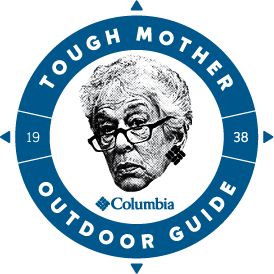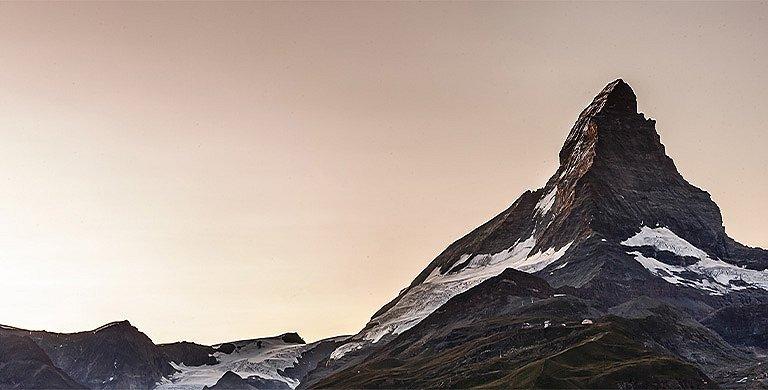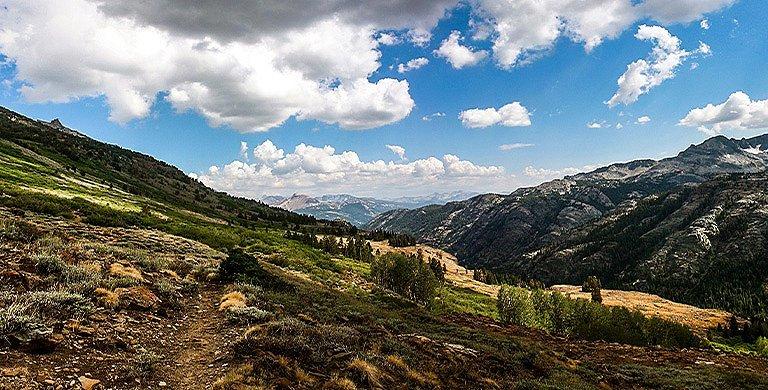
HIKING
Backpack Like a Guide: Smart Packing for Serious Trails
BY: NANCY BOUCHARD
“Perfection is achieved, not when there is nothing more to add, but when there is nothing left to take away. ”
Antoine de Saint-Exupéry
Backpacks are lifelines to the outdoor life--your gear garage when things get gritty. Whether you’re ridge-running, forest-slogging, desert-camping, bird-hunting, or bank-fishing, the right pack, loaded smart, can make the difference between a great day or starring in a B-grade survival saga.
We’ve been hauling gear since mammoths roamed. Early hunter-gatherers fashioned crude slings from leather, guts and fiber. Ötzi the Iceman, frozen mid-journey in the Alps some 5,000 years ago, had a stick-frame pack cobbled together.
Today’s packs are the same idea; sleeker, lighter, engineered marvels of ballistic nylon or polyester, ultralight framesheets, and padded suspension-- shoulder straps and hipbelts that fit like a best friend’s hug. But the wrong pack—or a badly loaded one—will punish you step after step. Your pack doesn’t care if it’s your first mile or your 500th. Neither does the trail.
“The best pack is the one you forget you’re wearing,” says Kristin Hostetter, longtime Backpacker gear editor who has tested many hundreds of backpacks over many thousands of miles. “If you’re constantly pulling at the shoulder straps or thinking about your screaming hips, you’re either carrying too much weight or have a pack that doesn’t fit your body.”
There’s no need to saw your toothbrush in half—but weight matters. Every ounce counts. Pack it wrong, and your hips, spine, and mood will mutiny. And on sketchy terrain, bad balance can mean a slip, a fall, or at the very least, a broken phone and a soggy PB&J.
We’ve been hauling gear since mammoths roamed. Early hunter-gatherers fashioned crude slings from leather, guts and fiber. Ötzi the Iceman, frozen mid-journey in the Alps some 5,000 years ago, had a stick-frame pack cobbled together.
Today’s packs are the same idea; sleeker, lighter, engineered marvels of ballistic nylon or polyester, ultralight framesheets, and padded suspension-- shoulder straps and hipbelts that fit like a best friend’s hug. But the wrong pack—or a badly loaded one—will punish you step after step. Your pack doesn’t care if it’s your first mile or your 500th. Neither does the trail.
“The best pack is the one you forget you’re wearing,” says Kristin Hostetter, longtime Backpacker gear editor who has tested many hundreds of backpacks over many thousands of miles. “If you’re constantly pulling at the shoulder straps or thinking about your screaming hips, you’re either carrying too much weight or have a pack that doesn’t fit your body.”
There’s no need to saw your toothbrush in half—but weight matters. Every ounce counts. Pack it wrong, and your hips, spine, and mood will mutiny. And on sketchy terrain, bad balance can mean a slip, a fall, or at the very least, a broken phone and a soggy PB&J.

Packing A Daypack
Packing a daypack isn’t rocket science because when you’re only carrying ten or so pounds, you really can’t get it wrong, says Hostetter. “It’s all about just having your essentials with you and having a modicum of organization so you know where everything is.” Keep a list of essentials: water, snacks, rain jacket, extra layer, brimmed hat, sunglasses, neck gaiter, headlamp. Packing smart means putting stuff you need close at hand, and the rest lower down in the pack. You don’t want to be the one dumping your pack’s contents on the trail to find that tube of sunscreen.
- Heavier, bulkier stuff at the bottom, centered in the packbag. Lighter gear—like extra layers--fills the gaps. Crushable food goes on top.
- Light or grab-and-go gear--rain shell, snacks, map—go in the lid, or outside stuff-it pouch.
- Nothing should dangle. Secure your gear—or leave it behind. Clipping a water bottle to a daisy chain is a bad choice on any continent.
- Use compression straps. They consolidate your load and keep it tight to your back.
- Ditch extras. One knife, one puffy, no Bluetooth speaker. Light is right.
Overnights & Multi-Day Packing
Packing for multiple days is an art. Do it right, and the trail flows. Do it wrong, and you’ll be focused on the weight, not the scenery. Stick to your packing list. Pack, unpack, sort gear, and repack before you head out on the trail or water.
Hostetter also suggests investing in a waterproof pack cover that’s sized for your pack. “While waterproof stuff sacks are always a good insurance policy, they can be expensive, and if you have a pack cover you can quickly deploy when the sprinkles start, your gear is protected.”
Hostetter also suggests investing in a waterproof pack cover that’s sized for your pack. “While waterproof stuff sacks are always a good insurance policy, they can be expensive, and if you have a pack cover you can quickly deploy when the sprinkles start, your gear is protected.”
- Core (spine-tight): Water, food, stove, and bear canister should be close to your spine for the best balance.
- Bottom: Sleeping bag, pad. Dry-bag it and forget it until camp.
- Middle zone: Tent body, cook kit, backup layers.
- Top/Lid: Rain shell, first aid, snacks, headlamp—grab 'n go.
- Outside: Trekking poles, foam pad. No clutter.
- Hipbelt or Shoulder Strap Pockets: phone, granola bars, lip balm.
- Pro Tip: Weigh everything. Then hike a few miles with it before heading out on the long-trail.
If the Pack Fits: Adjusting your Pack
Get your pack on and start from the bottom up:
- Hipbelt snug across hip bones—this carries the load.
- Shoulder straps: snug, not tugging or lifting the belt.
- Load lifters: tighten to pull weight forward.
- Sternum strap: light tension, not a chokehold.
- Readjust as needed as pack fit changes as your load shifts. “When I’m carrying a multiday pack over the course of a long day, I’m frequently making micro-adjustments to my straps because it allows me to shift the weight around and keep from straining any one part of my body,” says Hostetter. “Loosen the shoulder straps and you’ll feel the weight settle onto your hips to give your shoulders a rest. Then pull the load lifters tight to prevent sway. Cinch the shoulder straps back up to relieve sore hip bones. Repeat this constantly to keep heavy loads from taking a big toll.

Specialty Packs
You can get an all-purpose backpack, but once you’ve committed to an activity, you might want to look for something built for the task.
- Day hikes: Light and versatile.
- Backcountry Skiing: Water resistant, with a compartment for snow-safety gear.
- Backpacking: Suspension system required.
- Climbing: Lightweight, narrow with minimal padding.
- Fishing/Kayaking: Waterproof and access friendly.
- Hunting: Camouflage is everything.
- Dog Packs: Lightweight saddlebags for kibble.
Pack for the Place
- Mountain: Rope in the pack, crampons in an accessible protective bag, ice axe securely fastened with heads down and picks inward. Helmet in an exterior sleeve, chinstrap clipped to the pack.
- Desert: Water rules. Stash more than you think. Keep batteries and phone shaded, and snacks un-melted. Pack sun-protective apparel and keep your hat handy.
- Snow: Get a water-resistant pack and use a dry bag for your emergency layer. If you're in avalanche terrain, pack your shovel and probe where you can reach them.
- Water: You’ll want a dry bag with exterior pockets for stuff you need every five minutes. Bug spray and sunblock goes in the hipbelt pocket.
Hydration
- Bottles: Easy to fill, cheap, reliable—but you have to stop unless your pack has accessible side pockets.
- Reservoirs: Sip on the go, harder to clean, tough to track levels.
- Filters: Bring ‘em for long hauls. Know where your water sources are.
- Pro tip: Get a BPA-free, durable, and heat-resistant plastic bottle for longer hikes. HDPE (High-Density Polyethylene) ones are durable and widely recyclable.
- Keep it clean: Whatever water storage method you use, always wash it out after a trip.

Pockets: Some pack designers can’t help themselves—pockets everywhere. You want just the right amount. Too many, and you can’t find anything; too few, and it’s all a jumble. Hipbelt or shoulder strap pockets are ideal for your phone or a snack. Stash your headlamp and mini first-aid kit in the lid pocket and use an outside sleeve for your bottle if you're not running a hose and hydration reservoir. Inside the main packbag, look for a zippered sleeve for essentials like your passport or car keys. Ziplocks or ultralight dry bags help keep the rest sorted—and dry.
Pro Tip: Always pack your gear the same way and return to its home. It’s convenient for day hikes and crucial for multi-day trips. Headlamp? Top pocket—because fumbling in the dark sucks. Waterproof layer? Not buried, as you don’t want to be digging around your packbag in a deluge. Summit puffy? Easy to grab before your sweat-soaked body cools down faster than you can say hypothermia.
Waterproofing: Many packs are designed to be water-resistant—not submersible—but they can handle a downpour, like the ones in Olympic National Park. If your pack isn’t water-resistant—with waterproof zippers--you always add a pack cover, use a plastic garbage bag, or compartmentalize your critical gear in a dry bag—1 gallon freezer bags work great too.
Torso Length: Once you graduate from a book bag to a real load-hauler that is designed to rest on your hips, torso length matters. “I always suggest going into a good outdoor specialty shop and working with a packfitter, who can measure your torso and suggest the proper size,” says Hostetter. “I’ve seen people get it really wrong on their own and suffer the consequences. Just because you’re 6’3”, that doesn’t necessarily mean you need a size large pack. It’s all about the length of your torso–and that can vary greatly, even among people who are the same height.”
Packs 30L+ usually come in torso sizes—small, medium, large. Some have adjustable harnesses. Too short and the hipbelt won’t engage to support the load. Too long and the straps chafe. Measure your torso from the base of your neck to the top of your hips.
Pro Tip: Always pack your gear the same way and return to its home. It’s convenient for day hikes and crucial for multi-day trips. Headlamp? Top pocket—because fumbling in the dark sucks. Waterproof layer? Not buried, as you don’t want to be digging around your packbag in a deluge. Summit puffy? Easy to grab before your sweat-soaked body cools down faster than you can say hypothermia.
Waterproofing: Many packs are designed to be water-resistant—not submersible—but they can handle a downpour, like the ones in Olympic National Park. If your pack isn’t water-resistant—with waterproof zippers--you always add a pack cover, use a plastic garbage bag, or compartmentalize your critical gear in a dry bag—1 gallon freezer bags work great too.
Torso Length: Once you graduate from a book bag to a real load-hauler that is designed to rest on your hips, torso length matters. “I always suggest going into a good outdoor specialty shop and working with a packfitter, who can measure your torso and suggest the proper size,” says Hostetter. “I’ve seen people get it really wrong on their own and suffer the consequences. Just because you’re 6’3”, that doesn’t necessarily mean you need a size large pack. It’s all about the length of your torso–and that can vary greatly, even among people who are the same height.”
Packs 30L+ usually come in torso sizes—small, medium, large. Some have adjustable harnesses. Too short and the hipbelt won’t engage to support the load. Too long and the straps chafe. Measure your torso from the base of your neck to the top of your hips.
Pack Volume: Pick What You Need, Not What You Might Want
- 5–10L: Running, local parks, dog walks.
- 15–25L: Day hikes.
- 25–35L: All-day missions.
- 35–45L: Overnights.
- 55L+: Multi-day epics
Weigh In Time
Packing for multiple days is an art. Do it right, and the trail flows. Do it wrong, and you’ll be focused on the weight, not the scenery. Stick to your packing list. Pack, unpack, sort gear, and repack before you head out on the trail or water.
Hostetter also suggests investing in a waterproof pack cover that’s sized for your pack. “While waterproof stuff sacks are always a good insurance policy, they can be expensive, and if you have a pack cover you can quickly deploy when the sprinkles start, your gear is protected.”
Hostetter also suggests investing in a waterproof pack cover that’s sized for your pack. “While waterproof stuff sacks are always a good insurance policy, they can be expensive, and if you have a pack cover you can quickly deploy when the sprinkles start, your gear is protected.”
- Core (spine-tight): Water, food, stove, and bear canister should be close to your spine for the best balance.
- Bottom: Sleeping bag, pad. Dry-bag it and forget it until camp.
- Middle zone: Tent body, cook kit, backup layers.
- Top/Lid: Rain shell, first aid, snacks, headlamp—grab 'n go.
- Outside: Trekking poles, foam pad. No clutter.
- Hipbelt or Shoulder Strap Pockets: phone, granola bars, lip balm.
- Pro Tip: Weigh everything. Then hike a few miles with it before heading out on the long-trail.
If the Pack Fits: Adjusting your Pack
Consider weighing not just your pack, but each item before you go. Then you’ll have a benchmark for future trips. Do a practice hike around the block or at your local park, fully loaded. If it carries well for a few miles, you’re on your way to success and comfort. The first time you hike 25 miles with a 42-pound load because you couldn’t live without your French press and yoga mat, you’ll learn. Better to figure it out close to home than halfway up the pass in sideways sleet.
For your next outdoor adventure, make trip planning easy with Columbia’s versatile packs, apparel and footwear.



